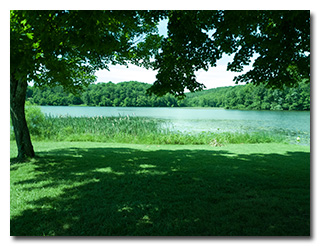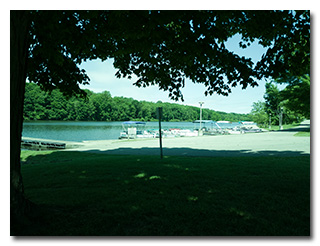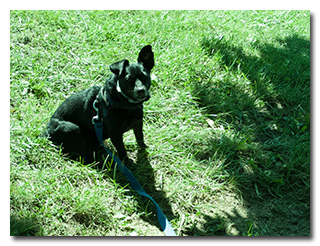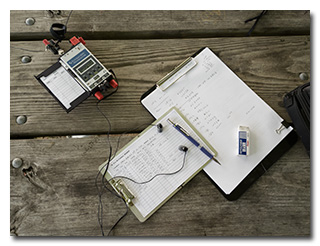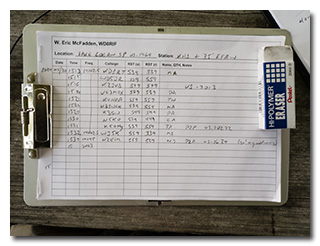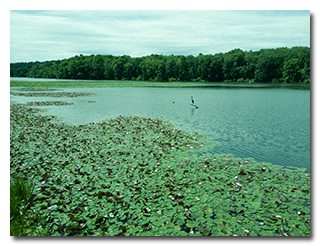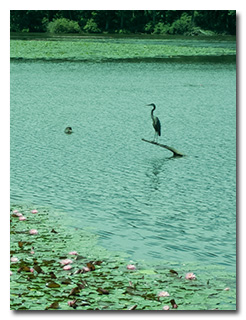
by William Eric McFadden
From the park's website:
-
Much time has passed since the region was first uplifted from the ancient sea that once covered most of Ohio. This unglaciated plateau is Ohio’s oldest landscape. The land was untouched by the ancient glaciers that invaded much of Ohio, which created a unique, rugged terrain that is not seen anywhere else in the state. The Hocking area was a major outlet for glacial meltwaters and deposited large amounts of outwash material of primarily sand and gravel. This resulted in a landscape marked by deep gorges, caves and waterfalls.
Predominately oak and hickory, the forest surrounding Lake Logan features white and black oak, tuliptree, shagbark and pignut hickory. The forest floor is speckled with a variety of wildflowers including fire pink, wintergreen, bluet and spring beauty. Ground cover plants include greenbriar, blueberry and numerous ferns and fungi.
Raccoon, opossum, skunk, red-backed salamander, gray squirrel, box turtle, white-tailed deer and wild turkey are all found in the park. Many birds frequent the area, making it an excellent place for birdwatching. The red-tailed hawk, barn owl, pileated woodpecker and scarlet tanager all call this area home. Various species of waterfowl can be viewed during spring and fall migration.
Pictures
- The view from Eric's picnic table: 1 | 2
- Theo-dog
- Eric's KH1 station
- Eric's log
- Great Blue Heron (and a closer view)
Description
On Thursday, May 30, 2024, one member of the Southeast Ohio Radio Adventure Team performed a successful activation of Lake Logan State Park in Ohio as part of the Parks on the Air (POTA; link) program.
While driving home after dropping his first-born off at John Glenn Columbus International Airport, Eric McFadden, WD8RIF, stopped at the boat-ramp area within Lake Logan State Park to perform a quick activation. Eric was accompanied by his wife Vickie and their two little dogs, Theo and Ginny.
The weather just about perfect for a POTA operation, with a temperature about 68° and a light breeze. Arriving at the boat-ramp area, Eric found several available picnic tables. Choosing one in the shade of a Maple tree, Eric set up his Elecraft KH1 in "table-top" configuration and deployed an under-test, ad-hoc 35' end-fed random wire (EFRW) antenna as a sloper up to the top of his Goture Red Fox Super Hard 720 carbon fiber mast supported on a spike, throwing a counterpoise wire on the ground. Eric was on the air at 1512 UTC.
(For his under-development KH1 Micro Travel Kit, Eric has been trying to find a suitable wire antenna to use when the included KH1's whip, with or without an Elecraft AXE1 40 coil, isn't sufficient. For this experiment, Eric extended the AXE1's included 33' counterpoise wire by 2' to use as a 35' radiator, and fed this through a bind-post adapter against the KH1's stock 13' counterpoise wire.)
As at his previous activations of this park, Eric had good cell-signal and he would be able to spot himself on POTA Spots (link) and to use POTA Spots to identify possible park-to-park (P2P) QSO opportunities.
After announcing his upcoming activation on POTA Spots and programming his KH1's CW memories, Eric began his operation on 20m by finding himself a clear frequency to run, beginning to call "CQ POTA", and was auto-spotted on POTA Spots, a nice indication that the 20m band wasn't in absolutely dismal condition and that his ad-hoc antenna was radiating some sort of a signal. Eric's first QSO came almost immediately at 1513 UTC with KD1RT in Massachusetts. QSOs came steadily, with Eric's tenth QSO coming at 1532 UTC with WJ5K in Mississippi. This run included a P2P QSO with K2JVB at Belmont Lake State Park (US-2013) in New York, a P2P QSO with K5OHY at Bush Family Home State Historic Site (US-10272) in Texas, and QSOs with stations located in Massachusetts (2), Oklahoma, New York, Pennsylvania (2), Tennessee, California, Texas, and Mississippi.
Pausing to hunt P2P QSOs, at 1532 UTC Eric completed a P2P QSO on 20m with N2EIM, who reported to Eric that he was activating Washington Crossing State Park (US-1634) in Delaware, but Eric later learned that 'EIM was actually performing a three-few activation of Washington Crossing State Park (US-1634), Delaware and Raritan Canal State Park (US-1613), and Lower Delaware National Wild and Scenic River (US-0684) in Delaware.
Wanting to give his KH1 and the under-test antenna a try on 40m, Eric found a clear frequency on that band, began to call "CQ POTA", and was quickly auto-spotted on on POTA Spots, an indication the band wasn't in terrible shape and that Eric's antenna was radiating at least a little bit of RF. However, after several minutes of calling CQ with no responses, and with his wife and dogs waiting patiently for him to finish playing with his radio, Eric finished his activation without making any QSOs on 40m.
In all, Eric made eleven QSOs, with five P2P QSOs including the three-fer. All of Eric's QSOs were CW and were made with five watts output.
Eric doesn't think the lack of success on 40m on this occasion was a reflection on the antenna or the radio; with an A-Index of 6 and a K-Index of 2, and with the N0NBH Solar Terrestrial Data widget showing 80m through 20m to be "poor", it's not surprising he didn't work anyone on the lower frequency.
Eric enjoyed using the KH1 for this activation, although he recognized that he might never really come to terms with the KHPD1 dual-lever CW paddle; the paddle is very small and he is much more comfortable using a single-lever paddle. Eric was pleased with the performance of his ad-hoc EFRW antenna and the KH1's internal ATU was easily able to find an acceptable match on all five of the bands the KH1 covers: 40, 30, 20, 17, and 15m.
Following tear down of the station, Eric, Vickie, and the dogs drove the short distance to downtown Logan for an excellent lunch at Shamrock Irish Pub. On the drive, while they were still alongside Lake Logan, they stopped to admire a Great Blue Heron standing just off the shore.
Eric also submitted his log to the World Wide Flora and Fauna in Amateur Radio (WWFF; link) program.
(return)
